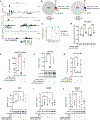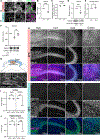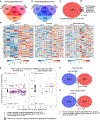SMYD5 is a regulator of the mild hypothermia response
- PMID: 39083378
- PMCID: PMC11401508
- DOI: 10.1016/j.celrep.2024.114554
SMYD5 is a regulator of the mild hypothermia response
Abstract
The mild hypothermia response (MHR) maintains organismal homeostasis during cold exposure and is thought to be critical for the neuroprotection documented with therapeutic hypothermia. To date, little is known about the transcriptional regulation of the MHR. We utilize a forward CRISPR-Cas9 mutagenesis screen to identify the histone lysine methyltransferase SMYD5 as a regulator of the MHR. SMYD5 represses the key MHR gene SP1 at euthermia. This repression correlates with temperature-dependent levels of histone H3 lysine 26 trimethylation (H3K36me3) at the SP1 locus and globally, indicating that the mammalian MHR is regulated at the level of histone modifications. We have identified 37 additional SMYD5-regulated temperature-dependent genes, suggesting a broader MHR-related role for SMYD5. Our study provides an example of how histone modifications integrate environmental cues into the genetic circuitry of mammalian cells and provides insights that may yield therapeutic avenues for neuroprotection after catastrophic events.
Keywords: CP: Metabolism; H3K36me3; SP1; cold stress; epigenetics; genetic environmental interaction; histone machinery; histone methylation; hypoxic brain injury; proteasome; repressor.
Copyright © 2024 The Author(s). Published by Elsevier Inc. All rights reserved.
Conflict of interest statement
Declaration of interests H.T.B. is a consultant for Mahzi Therapeutics and founder of Kaldur Therapeutics. S.R. and H.T.B. have a European patent application (23167505.9) on a therapeutic strategy to activate the MHR.
Figures





Update of
-
SMYD5 is a regulator of the mild hypothermia response.bioRxiv [Preprint]. 2024 Jul 12:2023.05.11.540170. doi: 10.1101/2023.05.11.540170. bioRxiv. 2024. Update in: Cell Rep. 2024 Aug 27;43(8):114554. doi: 10.1016/j.celrep.2024.114554. PMID: 37333301 Free PMC article. Updated. Preprint.
References
-
- Azzopardi D, Brocklehurst P, Edwards D, Halliday H, Levene M, Thoresen M, and Whitelaw A; TOBY Study Group (2008). The TOBY Study. Whole body hypothermia for the treatment of perinatal asphyxial encephalopathy: a randomised controlled trial. BMC Pediatr. 8, 17. 10.1186/1471-2431-8-17. - DOI - PMC - PubMed
-
- Gluckman PD, Wyatt JS, Azzopardi D, Ballard R, Edwards AD, Ferriero DM, Polin RA, Robertson CM, Thoresen M, Whitelaw A, and Gunn AJ (2005). Selective head cooling with mild systemic hypothermia after neonatal encephalopathy: Multicentre randomised trial. Lancet 365, 663–670. 10.1016/S0140-6736(05)17946-X. - DOI - PubMed
MeSH terms
Substances
Grants and funding
LinkOut - more resources
Full Text Sources
Molecular Biology Databases
Miscellaneous

